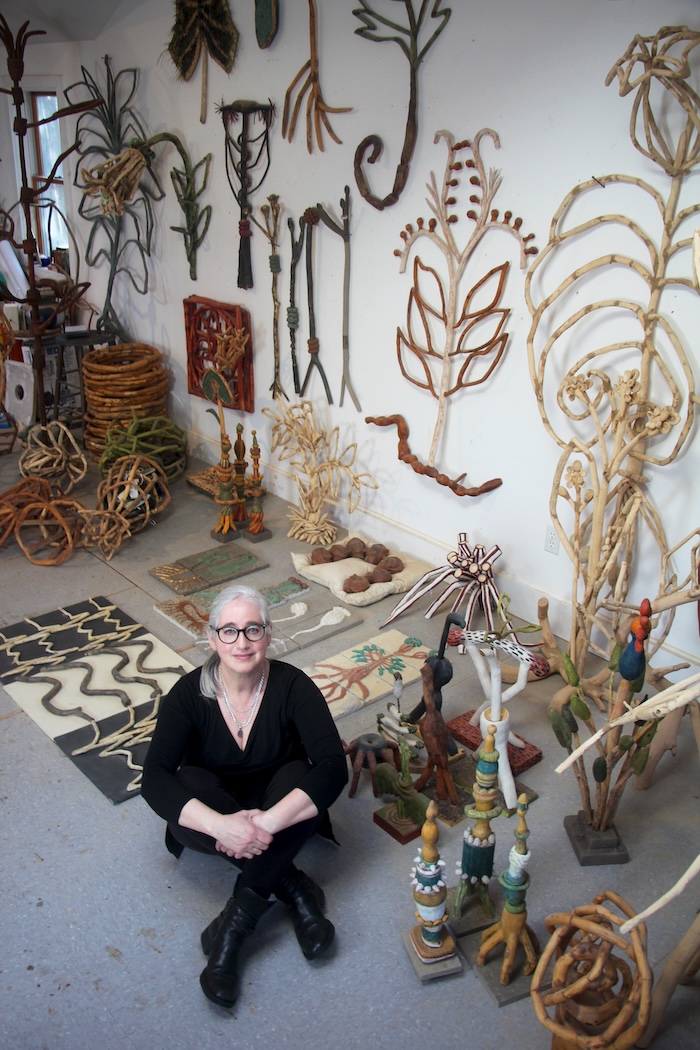
Sculptor rejoins wood left by the wayside
How did a Brooklyn girl get so attached to the woods?
For Loren Eiferman, it took hold at the Brooklyn Museum Art School. “I took a class each week, then wandered the halls; the African and South American collections with their totem poles, the extraordinary Egyptian wing, the Georgia O’Keefe watercolors, it all resonated so deeply,” she says.
Soon after, she moved to the Lower East Side of Manhattan, into an apartment with three tiny rooms. “It was August and so hot, but I turned my bedroom into my studio and made large oil paintings with gesso, 5-by-4 feet, but nothing would dry in the humidity.”
So she started whittling balsa. “I’m wired to be constantly creating things,” she recalls. “After eight hours went by, I found I had made this totem pole and thought, ‘Oh my god, I’m a sculptor, not a painter.’ ”
Eiferman began collecting sticks in Central Park and bringing them home on the subway. Friends who had cars drove her to the woods.
Some of the results will be on display at the BAU Gallery in Beacon, starting with a reception from 6 to 8 p.m. on Saturday (Feb. 10), as part of a two-person show with Midori Furutate called Alchemy/Paper and Sticks.
Eiferman says a big shift in her work came when she realized she was more interested in the shape of the wood, not just its utility as something to carve. “I learned that I wanted the wood and the shapes to speak for themselves,” she says.
She explains her technique: “I start each day collecting tree limbs and sticks; I never chop down a living tree or use green wood. Next, I debark the branch and look for shapes within each piece of wood. I cut and join these shapes. The open joints get filled with homemade putty and sanded. This process usually needs to be repeated at least three times.”
Each sculpture includes 100 to 200 pieces of joined wood and takes at least a month to build, she says. Or, as she notes, “it’s taken a lifetime to make them all.”
She hopes that viewers “have a sense of wonder and awe when looking at my work. We have all at one point or another picked up a stick from the ground, touched the wood, peeled the bark off with our fingernails. My work taps into that primal desire to touch nature and be close to it.
“The sculpture under construction appears like my line drawings but in space,” she adds. “I am interested in having my work appear as if it grew in nature. It’s the ultimate recycling, where I take detritus and give it a new life.”

Eiferman, who has a BFA from SUNY Purchase, takes a walk every morning from her Katonah home in search of material. She says her influences include the patterns in nature and plant life, images beamed back by the Hubble space telescope; ancient Buddhist mandalas and quantum physics.
Together with exhibiting this work at galleries, corporate collections and alternative art spaces, Eiferman has had quite a few interesting commissions, including one from the Cathedral of St. John the Divine in Manhattan for seven sculpted clay heads honoring women who started or influenced a world religion, and a 2014 piece for the Pelham Metro-North station in which she created a metal sculpture based on the William Morris Arts and Crafts decorative movement. “There was a serious learning curve for that one,” she says.
Eiferman is currently taking inspiration from the Voynich manuscript, which was written in a now-unknown language in the early 15th century and is filled with drawings of plants that don’t exist. For the past eight years, she’s been translating the images into sculptures. Another source of inspiration are the photographs of plants by Karl Blossfeldt.
She is not afraid to experiment. “I needed to finish off a sculpture with something translucent, with some stretch to it: I used pantyhose!” she says. “There’s always a discovery — new things are afoot!”
The BAU Gallery, at 506 Main St. in Beacon, is open Saturday and Sunday from noon to 6 p.m. See baugallery.org and loreneifermanart.com. The gallery also will exhibit Elemental Conversations, with wood-fired ceramics by Meg Beaudoin, who was the first-prize winner in BAU’s 2023 juried exhibition, and works by Mary McFerran. All three exhibits continue through March 10.

